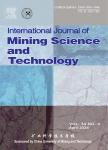Theoretical and experimental study on the rheological properties of WIS grout and the dispersion and sealing mechanism
Theoretical and experimental study on the rheological properties of WIS grout and the dispersion and sealing mechanism作者机构:ARC Research Hub for Computational Particle TechnologyDepartment of Chemical EngineeringMonash UniversityClayton 3800Australia Geotechnical and Structural Engineering Research CenterShandong UniversityJinan 250061China
出 版 物:《International Journal of Mining Science and Technology》 (矿业科学技术学报(英文版))
年 卷 期:2022年第32卷第4期
页 面:669-684页
核心收录:
学科分类:08[工学] 081304[工学-建筑技术科学] 0805[工学-材料科学与工程(可授工学、理学学位)] 080502[工学-材料学] 0813[工学-建筑学]
基 金:financially supported by National Postdoctoral Program for Innovative Talent (No. BX20200200) Youth Fund of National Natural Science Foundation of China (No. 52109126) Joint Funds of the National Natural Science Foundation of China (No. U1706223)
主 题:WIS grout material Grouting treatment Water inflow Sealing mechanism Flow regularity
摘 要:Recently a new grout material called water inflow sealing(WIS) was invented for sealing water inflow in tunneling and underground constructions. In this study, a special experimental method called intubated counter grouting(ICG) was proposed to investigate the influence of water dispersion on the rheological properties of the grout during the grouting process, and to testify the sealing performance of the grout,such as instant gelling ability(IGA) and anti-dispersion ability(ADA). In the experiment, dispersion was restricted in the downstream of the channel with a high turbulence intensity. The influences of ADA and IGA were therefore decoupled and evaluated separately. Experimental results revealed two distinctive sealing mechanisms of WIS. For a low initial velocity of water, WIS turned the shear flow of water into an overall movement of a plug by absorbing water into the particles. For a high initial velocity and the situation that the particles reached the outlet before sufficiently expanding, WIS modified the rheology of the water in the channel and reduced its velocity till the static state. The distinctive feature of WIS brings a reformation on the sealing mechanism and provides an effective way to control water inflow with high pressure and velocity.



